Illinois is known for Lake Michigan, there’s no doubt about that. Yet, with the wide selection of other stunning lakes and reservoirs in the state, it would be a shame to overlook any one of them. In addition, it turns out only one corner of the state really touches the great lake.
From lakes with zoos to several top-rated bass fishing spots, there are plenty of amazing bodies of water to visit and explore in Illinois. Other popular lakes offer outstanding catfish and high-speed boating opportunities. Illinois has large and small lakes that offer an entire range of outdoor recreational activities.
True crime enthusiasts may already know the horrific tale of the Karyn Hearn Slover murder at Lake Shelbyville. Illinois state history enthusiasts might know that Lake of Egypt is called the same thing that a certain part of the state once was and sports fans might know the town and its lake where the Chicago Bears originally got their start.
It all relates to lakes in the great state of Illinois.
Let’s examine 10 of the best lakes in Illinois and what makes each one outstanding!
1. Rend Lake
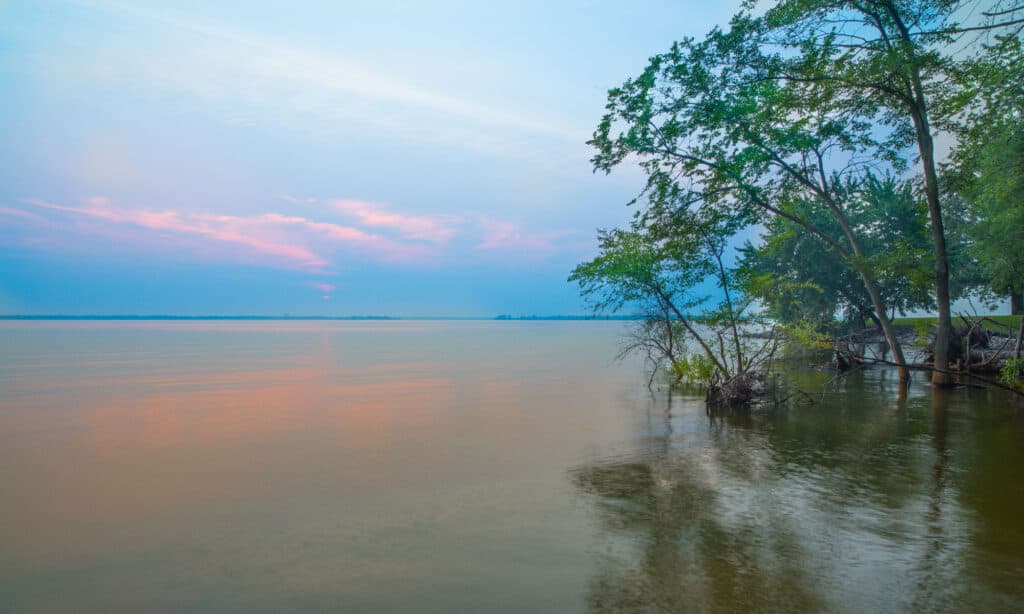
Rend Lake is known by anglers for outstanding crappie fishing. The lake is also a popular deer, duck, goose, and elk hunting spot
©iStock.com/Patrick Jennings
● Surface Area: 19,000 acres
● Max Depth: 35 Feet
● Camping/Overnight Available: Yes
● Boating/Docks Available: Yes
● Swimming Permitted: Yes
● Fishing Permitted: Yes
● Best For: Quiet & Family Friendly, Crappie Fishing Hot Spot
Rend Lake is located in Southern Illinois and is operated by the US Army Corps of Engineers. It’s a full-service lake offering fishing, camping, swimming, archery, hunting, boating, golf, and a number of other amenities and activities.
The north end of Rend Lake is more shallow and provides some of the best fishing the lake has to offer. Anglers know the lake for its excellent crappie fishing but many other species are in the water including flathead catfish, channel catfish, bluegill, blue catfish, largemouth bass, and white bass.
Hunting is another popular attraction at Rend Lake. Hunters can plan to target ducks, geese, pheasant, and deer in the area. The amenities for camping are outstanding at Rend Lake with over three hundred different options for day trips and overnight stays.
2. Lake Shelbyville
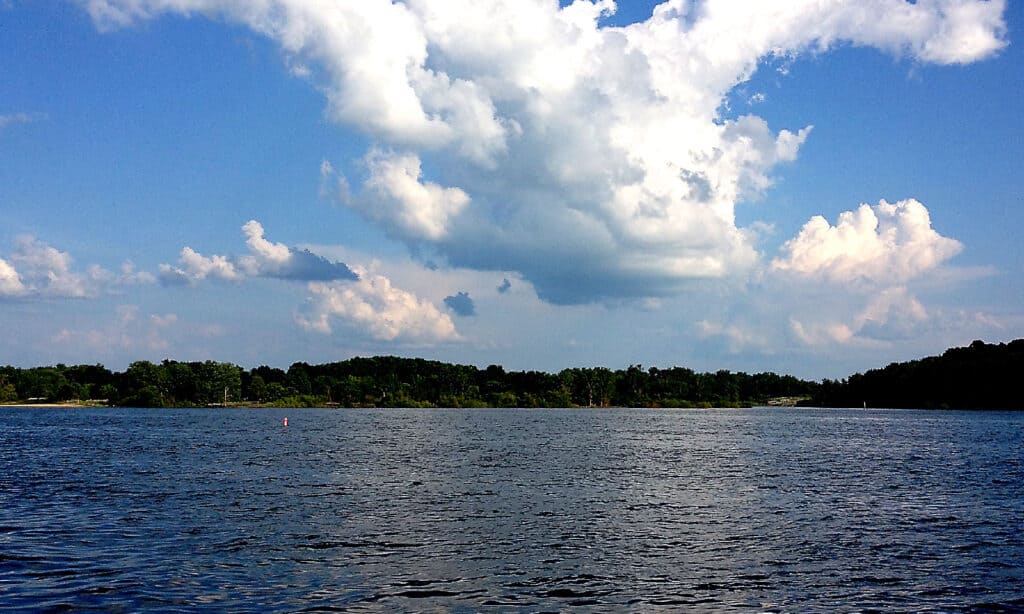
Lake Shelbyville provides an extensive amount of amenities and some of the best largemouth bass fishing in the midwest
©iStock.com/GagasGarden
● Surface Area: 11,000 acres
● Max Depth: 67 Feet
● Camping/Overnight Available: Yes
● Boating/Docks Available: Yes
● Swimming Permitted: Yes
● Fishing Permitted: Yes
● Best For: Record Sized Catfish & White Bass, ADA Fishing Pier, Murder of Karyn Hearn Slover
This centrally located lakes in Illinois truly has it all. Just a few of the amenities and activities available at Lake Shelbyville include horseback riding, four public beaches, fourteen golf courses, eight hiking trails, three full-service marinas, over one thousand campsites; there’s even a Wal-Mart!
In addition to the vast selection of services available, Lake Shelbyville provides some of the best largemouth bass fishing in the midwest. Other species anglers can be on the lookout for include catfish, largemouth bass, crappie, walleye, muskie, white bass, and bluegill.
Nearby Shelbyville State Fish and Wildlife Area provides habitat for other wildlife including gray and fox squirrels, dove, woodcock, raccoon, and coyote. Bow and shotgun hunting for deer, turkey, pheasant, coyotes, foxes, quail, and rabbits is also popular at Lake Shelbyville and the surrounding area. True crime enthusiasts can research the gruesome story of Karyn Hearn Slover; there was even a Forensic Files episode on it!
3. Crab Orchard Lake

Crab Orchard Lake has seen extensive restoration efforts helping it return to the “bass factory” it once was
©iStock.com/StMicca Photography
● Surface Area: 43,899 acres
● Max Depth: 25 Feet
● Camping/Overnight Available: Yes
● Boating/Docks Available: Yes
● Swimming Permitted: Yes
● Fishing Permitted: Yes
● Best For: Bass Fishing, Birdwatching, Deer Hunting
Crab Orchard Lake is surrounded by the forty-three thousand-acre Crab Orchard National Wildlife Refuge. The expansive and open environment creates a perfect home for a myriad of wildlife species. The waters were once referred to as a “bass factory” but environmental issues caused a decline in fish for a while.
Extensive restoration and stocking efforts over the years have turned things around and the fish are back. Today anglers can enjoy fishing for any of the following bluegill, channel catfish, flathead catfish, crappie, largemouth bass, and white bass.
The Crab Orchard National Wildlife Refuge is home to at least two hundred and forty-five bird species. Some of the birds seen in the area include crow, black vulture, pileated woodpecker, scarlet tanager, summer tanager, Kentucky warbler, northern parula, yellow-throated warbler, and prothonotary warbler. Visitors can also take advantage of the archery hunting of deer and waterfowl at Crab Orchard Lake.
4. Clinton Lake
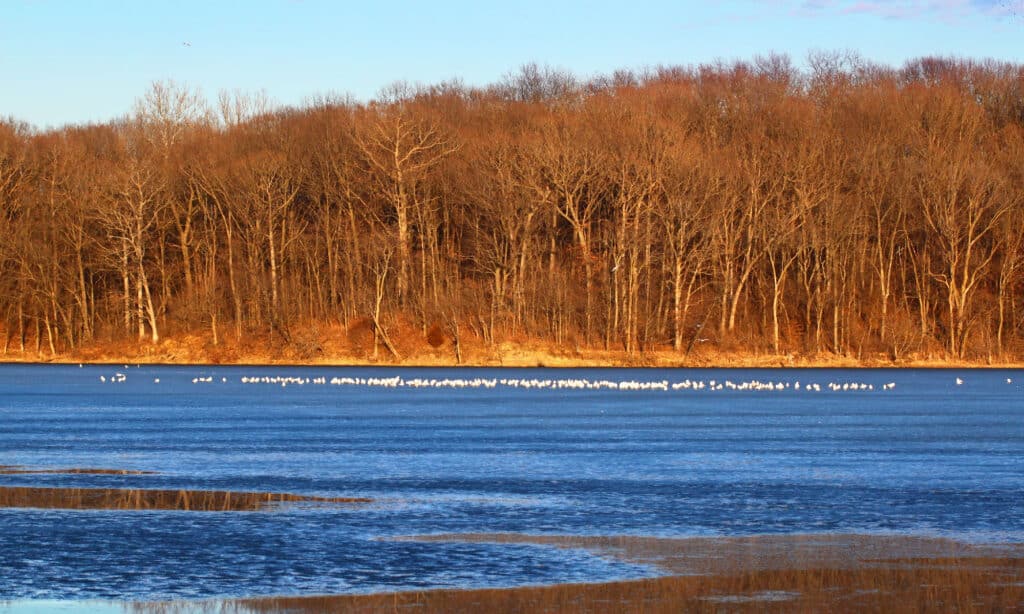
Clinton Lake is an excellent hunting, camping, and fishing getaway for Chicago locals and visitors to Illinois
©Jason Patrick Ross/Shutterstock.com
● Surface Area: 4,900 acres
● Max Depth: 48 Feet
● Camping/Overnight Available: Yes
● Boating/Docks Available: Yes
● Swimming Permitted: Yes
● Fishing Permitted: Yes
● Best For: University of Illinois’s Rowing Team Races, Sandy Swimming Beach
Clinton Lake was originally built in the 1970s to cool down the Clinton Nuclear Generating Station. The lake is a four-hour drive from Chicago and serves as a popular destination for camping, hunting, fishing, and a host of other outdoor recreational activities. The University of Illinois’s Rowing Team can be spotted often on Clinton Lake practicing or in the middle of a race.
Anglers enjoy Clinton Lake for its laid-back atmosphere and stellar fishing. Some of the species regularly seen at the lake include black crappie, blue catfish, channel catfish, flathead catfish, largemouth bass, hybrid striped bass, white bass, bullheads, and walleye. There are six boat launches around the lake and a one thousand foot long sandy beach for swimming.
Sailing is also popular at Clinton Lake and the Clinton Lake Sailing Association even offers sailing instructions. Hunters can take advantage of the lake and nine thousand three hundred acre Clinton Lake State Recreation Area for duck and goose hunting as available. Common birds seen around Clinton Lake include common goldeneye, common merganser, gadwall, ring-necked duck, and rusty blackbird.
5. Lake Springfield

Lake Springfield has it all, from great fishing to high-speed boating, swimming and paddleboarding; there’s even a nearby zoo!
©Walter L White/Shutterstock.com
● Surface Area: 4,260 acres
● Max Depth: 30 Feet
● Camping/Overnight Available: Yes
● Boating/Docks Available: Yes
● Swimming Permitted: Yes (Check regulations)
● Fishing Permitted: Yes
● Best For: High Powered Boating, Warm Water Fishing, Highly Ranked Fishing Lake, Abundant White Bass
Lake Springfield is an Illinois hotspot for outdoor fun and also the source of water for nearby Springfield. Fishing, high-speed boating, white bass fishing, and swimming are all popular activities at the lake. In addition, visitors enjoy kayaking, jet skiing, water skiing, tubing, and paddleboarding.
Fifteen species of fish inhabit Lake Springfield. Anglers can expect to find bluegill, channel catfish, flathead catfish, largemouth bass, white bass, white crappie, black crappie, green sunfish, green sunfish & bluegill hybrid, freshwater drum, redear sunfish, carp, walleye, saugeye, black bullhead, and yellow bullhead. Lake Springfield has fifty-seven miles of shoreline and six boat launches.
Swimming from the shoreline is not permitted, but visitors can swim from their boats or other designated areas. View the lake from the one thousand three hundred and ninety-four foot Vachel Lindsay Bridge that spans the entire lake. There are several other nearby attractions at Lake Springfield including eight public parks, the University of Illinois Springfield, Abraham Lincoln Memorial Garden, and Henson Robinson Zoo.
6. Lake Decatur

Lake Decatur is the largest artificial body of water in Illinois and its waters are known for excellent catfish
©iStock.com/rwhitacre
● Surface Area: 2,800 acres
● Max Depth: 22 Feet
● Camping/Overnight Available: No, Nearby Hotels
● Boating/Docks Available: Yes
● Swimming Permitted: Yes
● Fishing Permitted: Yes
● Best For: Abundant Channel Catfish, Provides Water to Decatur, Relaxing Atmosphere
Lake Decatur is Located on the east side of Decatur Illinois. Tourists and locals can enjoy fishing, boating, swimming, miniature golf, sailing, and many other outdoor recreational activities in close proximity to the city. The lake is the largest artificial body of water in Illinois and also borders nearby Faries Park, Nelson Park, and Scovill Zoo.
Anglers know the lake for channel catfish but many other types of fish are in abundance at the lake. Some of the other species that call the lake their home include striped bass, wiper hybrid bass, walleye, bluegill, carp, crappie, flathead catfish, freshwater drum, largemouth bass, white bass, yellow bass, longear sunfish, green sunfish, orangespotted sunfish, and yellow bullheads. Boat ramps are available at the lake and anglers can find opportunities along the thirty miles of shoreline to get a hook into the water.
Many different types of birds also frequent the lake giving birdwatchers and wildlife enthusiasts an opportunity to do some viewing. A few of the different birds around the lake include American white pelicans, eagles, green heron, kingfisher, mallards, blue-winged teal, pied-billed grebes, coots, redheads, canvasbacks, and geese. The city of Decatur was actually the original home of the Chicago Bears and the “Soybean Capital of the World.”
7. Kinkaid Lake
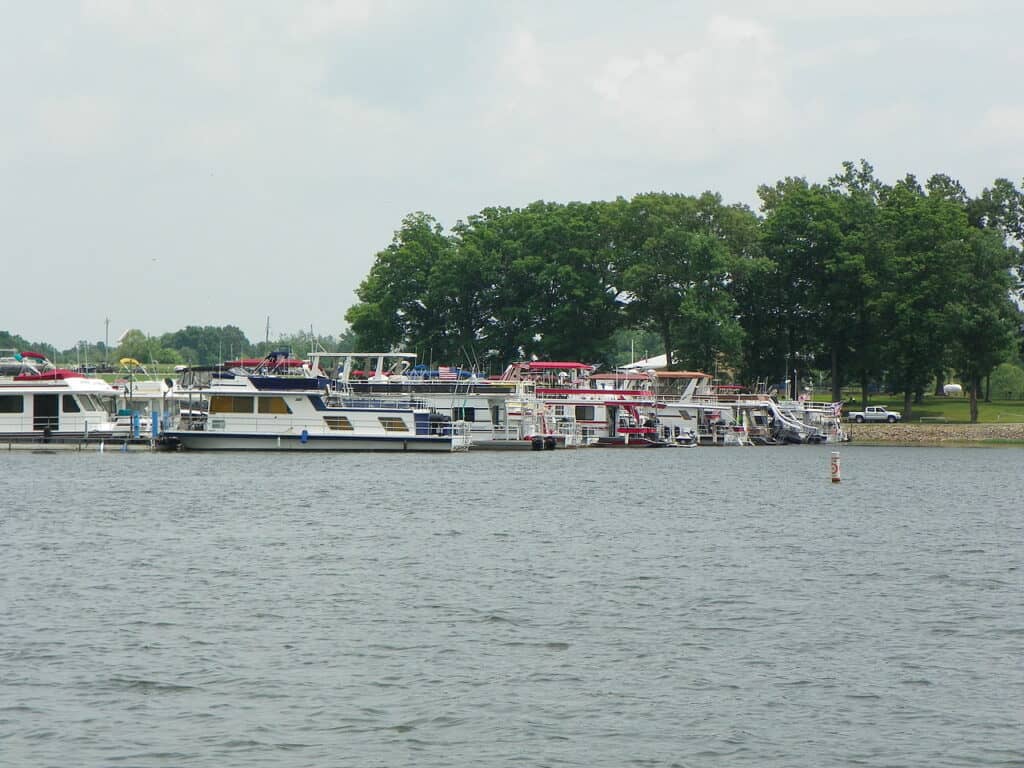
Kinkaid Lake is known to be a hotspot for hunting and muskie fishing; its waters have produced some massive size fish
©Markkaempfer / Creative Commons – License
● Surface Area: 2,750 acres
● Max Depth: 80 Feet
● Camping/Overnight Available: Yes
● Boating/Docks Available: Yes
● Swimming Permitted: Yes
● Fishing Permitted: Yes
● Best For: Premier Muskie Lake, Hunting
Kinkaid Lake is a serene, beautiful body of water. Its shoreline is untouched by residential buildings providing a relaxing outdoor recreational environment for the entire family. This is a full-service lake with four boat ramps, a marina, a restaurant, and camping; “The Spillway” by the dam is a popular attraction for photographers.
Anglers have called it the Premier Muskie Lake. The waters were stocked with natural strain muskellunge in the eighties which are heavily abundant today. Other fish that inhabit Kinkaid Lake include blacknose crappie, black crappie, white crappie, bluegill, channel catfish, largemouth bass, muskie, redear sunfish, and walleye.
Hunting is popular at Kinkaid Lake; targeted species include deer, turkey, squirrel, quail, rabbit, dove, and waterfowl. For a unique experience, visitors can stay at Johnson Creek Campground; it’s one of the few Forest Service campgrounds that allow equestrians and their stock.
8. Horseshoe Lake
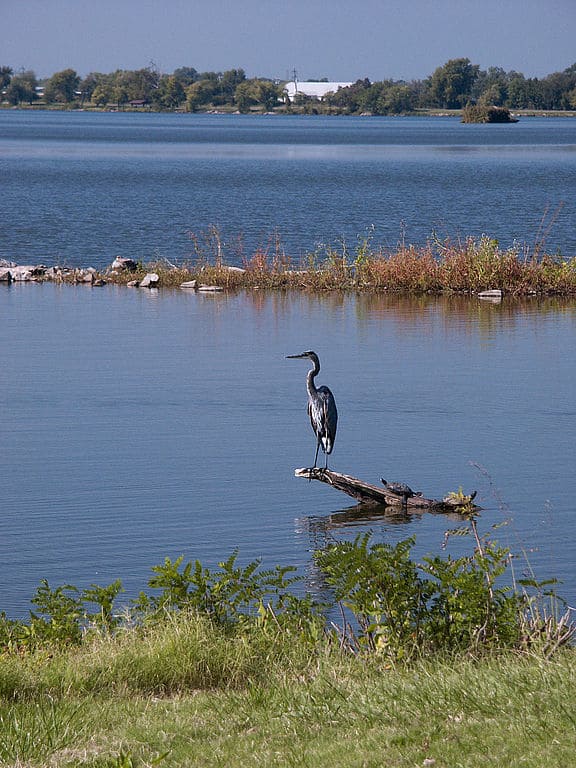
Horseshoe Lake is a National Natural Landmark, excellent for birdwatching and hunting
©Marcusscotus1 / Creative Commons – License
● Surface Area: 1,890 acres
● Max Depth: 6 Feet
● Camping/Overnight Available:
● Boating/Docks Available: Yes
● Swimming Permitted: No
● Fishing Permitted: Yes
● Best For: National Natural Landmark, Excellent Birding, Hunting, Quiet & Secluded
Horseshoe Lake is actually shaped like a horseshoe and is the second-largest natural lake in Illinois. The habitat is reminiscent of a swamp from down south; paired with bald cypress, tupelo gum trees, and dangling moss.
Fishing at Horseshoe Lake is popular because of its unique habitat. Some of the fish swimming in the water include bluegill, channel catfish, crappie, largemouth bass, Asian carp, silver carp, bighead carp, alligator gar, bigmouth buffalo, yellow bass, sunfish, and shortnose gar.
Horseshoe Lake visitors can take advantage of over four thousand acres of huntable land. Species targeted by hunters include deer, duck, geese, squirrels, rabbits, crow, quail, and pheasant. Deer archery and furbearer trapping are the more popular hunting-related activities available at the lake.
Birding enthusiasts will be thrilled at Horseshoe Lake for the diverse range of species and frequency of viewability. Some of the birds reported to have been seen at Horseshoe Lake include Canadian geese, bald eagles, great egrets, snowy egrets, American white pelicans, double-crested cormorants, neotropical cormorant, black-crowned night-herons, and Eurasian tree sparrow.
9. Lake of Egypt

Lake of Egypt gets its unique name because it’s the same thing Southern Illinois was once called!
©Lucas W/Shutterstock.com
● Surface Area: 2,300 acres
● Max Depth: 52 Feet
● Camping/Overnight Available: Yes
● Boating/Docks Available: Yes
● Swimming Permitted: Yes
● Fishing Permitted: Yes
● Best For: Southern Illinois Hidden Treasure, Unique Trees
Lake of Egypt can be found six miles south of Marion in Southern Illinois. The lake is owned by the Southern Illinois Power Cooperative which allow public access to much of the area. The reason for the strange name is linked to how Southern Illinois used to be called “Lake of Egypt”; history still remains unclear exactly why.
Fishing and hunting are both popular activities at Lake of Egypt. Waterfowl hunters can utilize public hunting blinds provided around the lake. Anglers can try their luck catching channel catfish, striped bass, crappie, bluegill, carp, and buffalo from designated areas along the ninety miles of shoreline or from the boat.
Nearby Crab Orchard National Wildlife Refuge is home to nearly a thousand species of plants, animals, and fish. Another attraction, Walker’s Island Trail, is highly rated and there are multiple reports of frogs, snakes, and other wildlife around to view for hikers.
The Largest Lake Entirely In Illinois
While Lake Michigan is the largest lakes in Illinois, it touches other states such as Indiana, Wisconsin, and Michigan itself. With that in mind, you might be wondering what’s the largest lake entirely in the state of Illinois?
10. Carlyle Lake

Carlyle Lake is the largest lake entirely in the state of Illinois and offers an exhaustive list of activities and amenities
©Jason Patrick Ross/Shutterstock.com
● Surface Area: 25,000 acres
● Max Depth: 35 Feet
● Camping/Overnight Available: Yes
● Boating/Docks Available: Yes
● Swimming Permitted: Yes
● Fishing Permitted: Yes
● Best For: Largest Lake Entirely Within Illinois, Challenging Sailboat Waters,
Carlyle Lake is the largest lake entirely within the state of Illinois. It’s fifty miles east of St Louis Missouri and six hours from Chicago. The size and location of the lake enable an exhaustive list of amenities. Lake visitors can utilize the lodges, bed & breakfasts, hotels, five beaches, numerous boat ramps, five campgrounds, and over three hundred other smaller campsites available.
The northern and southern parts of Carlyle Lake are divided by train tracks creating two different environments. The upper area of the lake is shallow, making it a good home for bass and crappie. Other fish anglers can expect to find are catfish, bluegill, flathead catfish, white bass, and largemouth bass.
Carlyle Lake is an excellent spot for birdwatching. Some of the largest waterfowl concentrations in the entire state gather at the lake. Many other bird and wildlife species can be seen in the area. Just a few of the birds you can spot include snow geese, greater white-fronted geese, wood duck, blue-winged teal, northern shoveler, gadwall, mallard, northern pintail, canvasback, ring-necked duck, long-tailed duck, bufflehead, hooded merganser, red-breasted merganser, ruddy duck, pied-billed grebe, rock pigeon, mourning dove, American coot, killdeer, pectoral sandpiper, Wilson’s snipe, eastern bluebird, American robin, house sparrow, American pipit, American goldfinch, dark-eyed junco, song sparrow, swamp sparrow, eastern towhee, eastern meadowlark, red-winged blackbird, brown-headed cowbird, common grackle, pine warbler, and northern cardinal.
The photo featured at the top of this post is © iStock.com/StMicca Photography
Thank you for reading! Have some feedback for us? Contact the AZ Animals editorial team.






